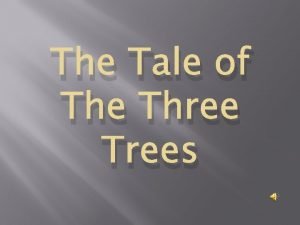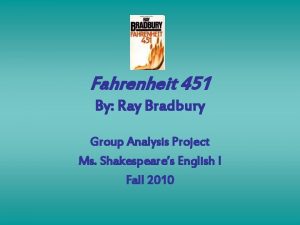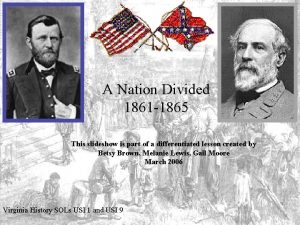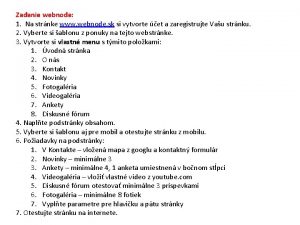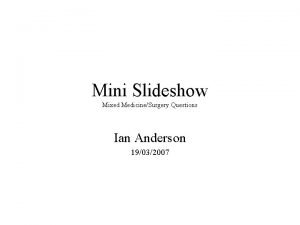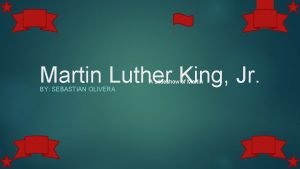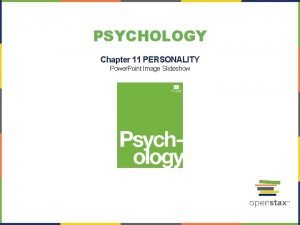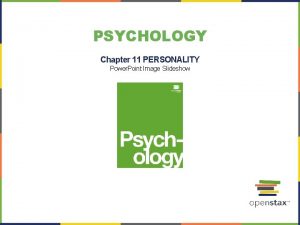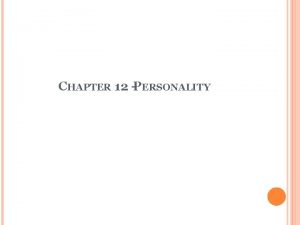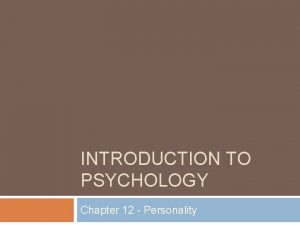PSYCHOLOGY Chapter 11 PERSONALITY Power Point Image Slideshow




















- Slides: 20

PSYCHOLOGY Chapter 11 PERSONALITY Power. Point Image Slideshow

FIGURE 11. 1 What makes two individuals have different personalities? (credit: modification of work by Nicolas Alejandro) This Open. Stax ancillary resource is © Rice University under a CC-BY 4. 0 International license; it may be reproduced or modified but must be attributed to Open. Stax, Rice University and any changes must be noted. Any images credited to other sources are similarly available for reproduction, but must be attributed to their sources.

FIGURE 11. 2 Happy, sad, impatient, shy, fearful, curious, helpful. What characteristics describe your personality? This Open. Stax ancillary resource is © Rice University under a CC-BY 4. 0 International license; it may be reproduced or modified but must be attributed to Open. Stax, Rice University and any changes must be noted. Any images credited to other sources are similarly available for reproduction, but must be attributed to their sources.

FIGURE 11. 3 The pseudoscience of measuring the areas of a person’s skull is known as phrenology. (a) Gall developed a chart that depicted which areas of the skull corresponded to particular personality traits or characteristics (Hothersall, 1995). (b) An 1825 lithograph depicts Gall examining the skull of a young woman. (credit b: modification of work by Wellcome Library, London) This Open. Stax ancillary resource is © Rice University under a CC-BY 4. 0 International license; it may be reproduced or modified but must be attributed to Open. Stax, Rice University and any changes must be noted. Any images credited to other sources are similarly available for reproduction, but must be attributed to their sources.

FIGURE 11. 4 Developed from Galen’s theory of the four temperaments, Kant proposed trait words to describe each temperament. Wundt later suggested the arrangement of the traits on two major axes. This Open. Stax ancillary resource is © Rice University under a CC-BY 4. 0 International license; it may be reproduced or modified but must be attributed to Open. Stax, Rice University and any changes must be noted. Any images credited to other sources are similarly available for reproduction, but must be attributed to their sources.

FIGURE 11. 5 Freud believed that we are only aware of a small amount of our mind’s activities and that most of it remains hidden from us in our unconscious. The information in our unconscious affects our behavior, although we are unaware of it. This Open. Stax ancillary resource is © Rice University under a CC-BY 4. 0 International license; it may be reproduced or modified but must be attributed to Open. Stax, Rice University and any changes must be noted. Any images credited to other sources are similarly available for reproduction, but must be attributed to their sources.

FIGURE 11. 6 The job of the ego, or self, is to balance the aggressive/pleasure-seeking drives of the id with the moral control of the superego. This Open. Stax ancillary resource is © Rice University under a CC-BY 4. 0 International license; it may be reproduced or modified but must be attributed to Open. Stax, Rice University and any changes must be noted. Any images credited to other sources are similarly available for reproduction, but must be attributed to their sources.

FIGURE 11. 7 Defense mechanisms are unconscious protective behaviors that work to reduce anxiety. This Open. Stax ancillary resource is © Rice University under a CC-BY 4. 0 International license; it may be reproduced or modified but must be attributed to Open. Stax, Rice University and any changes must be noted. Any images credited to other sources are similarly available for reproduction, but must be attributed to their sources.

FIGURE 11. 8 Alfred Adler proposed the concept of the inferiority complex. This Open. Stax ancillary resource is © Rice University under a CC-BY 4. 0 International license; it may be reproduced or modified but must be attributed to Open. Stax, Rice University and any changes must be noted. Any images credited to other sources are similarly available for reproduction, but must be attributed to their sources.

FIGURE 11. 9 Carl Jung was interested in exploring the collective unconscious. This Open. Stax ancillary resource is © Rice University under a CC-BY 4. 0 International license; it may be reproduced or modified but must be attributed to Open. Stax, Rice University and any changes must be noted. Any images credited to other sources are similarly available for reproduction, but must be attributed to their sources.

FIGURE 11. 10 Bandura proposed the idea of reciprocal determinism: Our behavior, cognitive processes, and situational context all influence each other. This Open. Stax ancillary resource is © Rice University under a CC-BY 4. 0 International license; it may be reproduced or modified but must be attributed to Open. Stax, Rice University and any changes must be noted. Any images credited to other sources are similarly available for reproduction, but must be attributed to their sources.

FIGURE 11. 11 Locus of control occurs on a continuum from internal to external. This Open. Stax ancillary resource is © Rice University under a CC-BY 4. 0 International license; it may be reproduced or modified but must be attributed to Open. Stax, Rice University and any changes must be noted. Any images credited to other sources are similarly available for reproduction, but must be attributed to their sources.

FIGURE 11. 12 Sheldon proposed three somatotypes: endomorphs, mesomorphs, and ectomorphs. Do you think Sheldon’s ideas about somatotypes are generally accurate about most people? This Open. Stax ancillary resource is © Rice University under a CC-BY 4. 0 International license; it may be reproduced or modified but must be attributed to Open. Stax, Rice University and any changes must be noted. Any images credited to other sources are similarly available for reproduction, but must be attributed to their sources.

FIGURE 11. 13 Hans and Sybil Eysenck believed that our personality traits are influenced by our genetic inheritance. (credit: "Sirswindon"/Wikimedia Commons) This Open. Stax ancillary resource is © Rice University under a CC-BY 4. 0 International license; it may be reproduced or modified but must be attributed to Open. Stax, Rice University and any changes must be noted. Any images credited to other sources are similarly available for reproduction, but must be attributed to their sources.

FIGURE 11. 14 The Eysencks described two factors to account for variations in our personalities: extroversion/introversion and emotional stability/instability. This Open. Stax ancillary resource is © Rice University under a CC-BY 4. 0 International license; it may be reproduced or modified but must be attributed to Open. Stax, Rice University and any changes must be noted. Any images credited to other sources are similarly available for reproduction, but must be attributed to their sources.

FIGURE 11. 15 In the Five Factor Model, each person has five traits, each scored on a continuum from high to low. In the center column, notice that the first letter of each trait spells the mnemonic OCEAN. This Open. Stax ancillary resource is © Rice University under a CC-BY 4. 0 International license; it may be reproduced or modified but must be attributed to Open. Stax, Rice University and any changes must be noted. Any images credited to other sources are similarly available for reproduction, but must be attributed to their sources.

FIGURE 11. 16 Researchers found three distinct regional personality clusters in the United States. People tend to be friendly and conventional in the Upper Midwest and Deep South; relaxed, emotionally stable, and creative in the West; and stressed, irritable, and depressed in the Northeast (Rentfrow et al. , 2013). This Open. Stax ancillary resource is © Rice University under a CC-BY 4. 0 International license; it may be reproduced or modified but must be attributed to Open. Stax, Rice University and any changes must be noted. Any images credited to other sources are similarly available for reproduction, but must be attributed to their sources.

FIGURE 11. 17 If you’ve ever taken a survey, you are probably familiar with Likert-type scale questions. Most personality inventories employ these types of response scales. This Open. Stax ancillary resource is © Rice University under a CC-BY 4. 0 International license; it may be reproduced or modified but must be attributed to Open. Stax, Rice University and any changes must be noted. Any images credited to other sources are similarly available for reproduction, but must be attributed to their sources.

FIGURE 11. 18 These true/false questions resemble the kinds of questions you would find on the MMPI. This Open. Stax ancillary resource is © Rice University under a CC-BY 4. 0 International license; it may be reproduced or modified but must be attributed to Open. Stax, Rice University and any changes must be noted. Any images credited to other sources are similarly available for reproduction, but must be attributed to their sources.

FIGURE 11. 19 These incomplete sentences resemble the types of questions on the RISB. How would you complete these sentences? This Open. Stax ancillary resource is © Rice University under a CC-BY 4. 0 International license; it may be reproduced or modified but must be attributed to Open. Stax, Rice University and any changes must be noted. Any images credited to other sources are similarly available for reproduction, but must be attributed to their sources.
 Power trianlge
Power trianlge Informsu
Informsu Point point power
Point point power Tommy's window slideshow prayer
Tommy's window slideshow prayer The tale of 3 trees
The tale of 3 trees Pelajaran sekolah sabat dewasa
Pelajaran sekolah sabat dewasa Slideshow naruto
Slideshow naruto Dust bowl slideshow
Dust bowl slideshow Multiplication slideshow
Multiplication slideshow Who is the lord of the flies in chapter 8
Who is the lord of the flies in chapter 8 Summary of farenheight 451
Summary of farenheight 451 Franck-condon principle lecture notes
Franck-condon principle lecture notes Slideshow
Slideshow Webnode stránky
Webnode stránky Probability slideshow
Probability slideshow Open house slideshow
Open house slideshow Which term is used to describe bitmap images?
Which term is used to describe bitmap images? Grade 9 electricity notes
Grade 9 electricity notes Jacob and esau slideshow
Jacob and esau slideshow Color 19032007
Color 19032007 Martin luther king jr slideshow
Martin luther king jr slideshow




